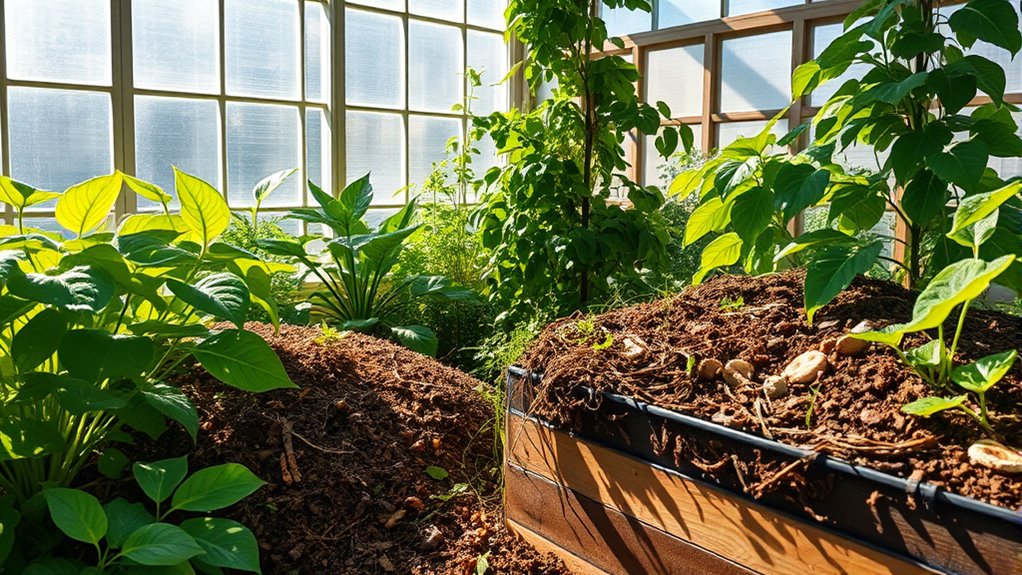Composting inside your greenhouse has great benefits, like providing nutrient-rich soil, extending your growing season, and reducing waste. However, you’ll face challenges too, such as limited space, heat management, and the risk of contamination. It’s essential to consider health and safety, as well as costs, which can offset long-term savings. By carefully weighing these pros and cons, you can enhance your gardening experience and achieve better results. Discover more about effective composting practices and sustainability now!
Key Takeaways
- Composting in a greenhouse provides nutrient-rich soil year-round, enhancing plant growth and crop yields.
- Decomposition generates heat, extending the growing season and reducing heating costs.
- Limited space and heat management complexities require careful planning and regular maintenance.
- Risks include contamination from excess nitrogen and potential odors if not managed properly.
- Composting diverts waste from landfills, supporting sustainability and minimizing environmental impact.
Benefits of Composting Inside a Greenhouse

Composting inside a greenhouse offers numerous benefits that can enhance your gardening experience. You can enjoy year-round composting, regardless of the weather outside, ensuring a continuous supply of nutrient-rich soil.
As organic matter decomposes, it generates heat, warming your greenhouse and extending your growing season. This process also helps maintain optimal CO2 levels, promoting healthy plant growth.
By composting, you’re reducing waste that would otherwise end up in landfills, contributing to a more sustainable practice. Additionally, compost improves soil quality, enhancing fertility and structure for better crop yields.
You’ll also support biodiversity by fostering beneficial organisms, creating a healthier ecosystem for your plants. Overall, composting in your greenhouse is a smart, eco-friendly choice!
Challenges of Composting Inside a Greenhouse
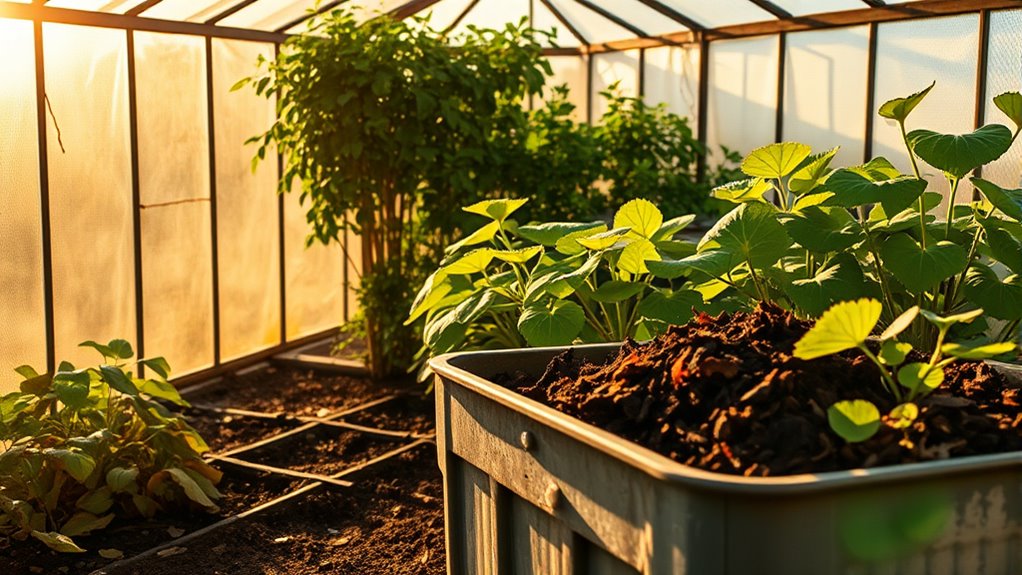
While composting offers many benefits, it also presents several challenges when done inside a greenhouse.
First, you’ll need to dedicate space for composting, which can be limited. The layout must accommodate equipment and ensure good ventilation to prevent moisture buildup.
Heat management is another concern; capturing and distributing heat from composting can be complex, requiring systems that demand regular maintenance.
You also face operational challenges, like the need for consistent monitoring and turning of compost piles.
Plus, contamination risks from excess nitrogen and leachate can harm plant growth.
Lastly, the initial setup costs may be high, and you’ll need time to see economic benefits.
Balancing all these factors is key to successful greenhouse composting.
Environmental Impact of Greenhouse Composting

The challenges of composting in a greenhouse shouldn’t overshadow its significant environmental benefits. By diverting organic waste from landfills, you effectively reduce methane emissions, a major greenhouse gas.
Composting also recycles nutrients back into the soil, enhancing its health and fertility. When you use compost, it helps store carbon, lowering atmospheric CO2 levels. Additionally, using high-quality crystal glassware and decanters for your beverages during gardening breaks can elevate your outdoor experience while you work. Furthermore, adopting practices such as solar energy solutions can complement the composting process by providing renewable energy for greenhouse operations. Moreover, investing in green technologies can further support your greenhouse’s sustainability efforts.
Composting enriches soil health by recycling nutrients and storing carbon, effectively reducing atmospheric CO2 levels.
Additionally, proper composting practices minimize harmful emissions like methane and nitrous oxide, which can arise from poorly managed piles. This process can decrease your reliance on synthetic fertilizers, further cutting emissions. Additionally, adopting sustainable practices in gardening can promote cleaner energy sources, which is essential for reducing the environmental impact of traditional methods.
In essence, greenhouse composting not only aids in waste management but also supports sustainable agriculture, making your gardening practices more eco-friendly and efficient.
Health and Safety Considerations

Ensuring health and safety in greenhouse composting is crucial for protecting both you and your plants. Be mindful that compost materials can harbor harmful pathogens, particularly if temperatures don’t reach the required levels.
Avoid risky inputs like raw poultry or pet waste, and recognize that molds may trigger allergies in sensitive individuals. Always wash your hands after handling compost and consider wearing gloves and masks for added protection.
Managing moisture and aerating regularly helps reduce pathogens and keeps the compost healthy. Additionally, maintain clear access around compost piles to prevent accidents.
With careful attention to these factors, you can enjoy the benefits of composting while minimizing health and safety risks in your greenhouse.
Cost and Resource Efficiency
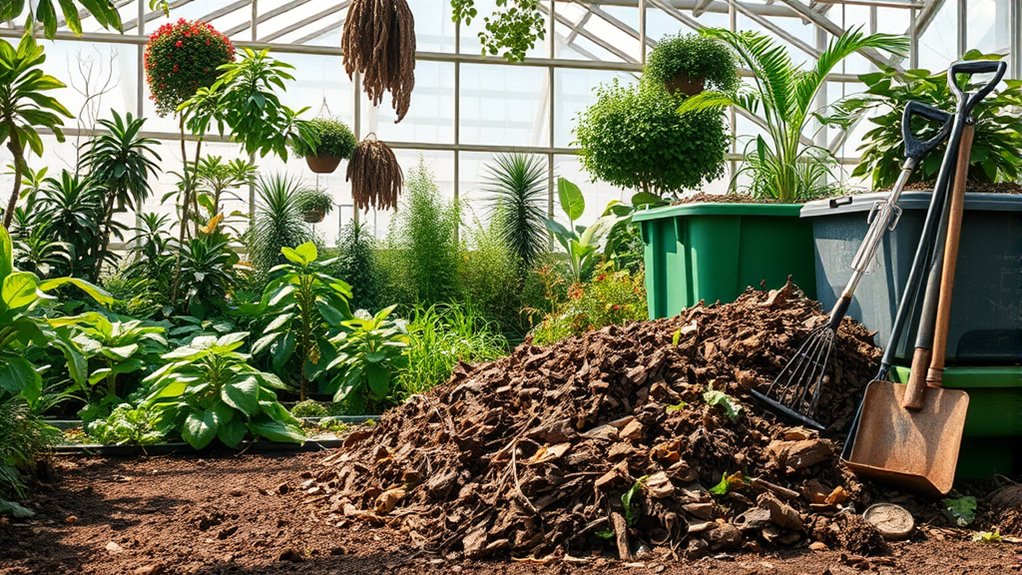
Managing health and safety in greenhouse composting not only protects you and your plants but also opens the door to significant cost and resource efficiency.
By composting, you can cut down on fertilizer costs, utilizing nutrient-rich compost instead. Plus, the heat generated during composting can reduce your reliance on external heating sources, saving energy.
You’ll also lower waste disposal fees by diverting organic waste from landfills. Efficient composting can increase your revenue through compost sales while optimizing water use and enhancing soil health.
Although there’s an initial investment, the long-term savings and benefits make it worthwhile. Ultimately, composting transforms waste into valuable resources, creating a sustainable cycle right within your greenhouse.
Alternatives to Greenhouse Composting
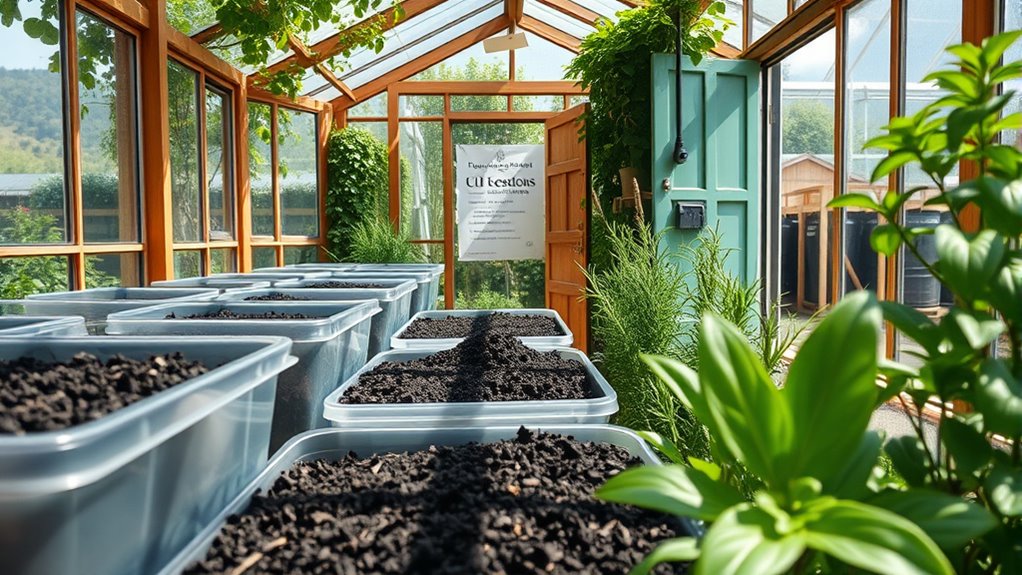
Many gardeners explore alternatives to greenhouse composting to find solutions that fit their specific needs and space constraints.
Consider vermicomposting, which uses worms to efficiently break down organic waste indoors. Effective Microorganisms (EMO) and Bokashi systems also offer indoor composting options, allowing you to compost a wider variety of materials, including meat and dairy.
If you prefer a low-maintenance option, electric food recyclers quickly process food scraps into nutrient-rich fertilizer. For those who want less hands-on involvement, external composting services can collect your organic waste and handle the processing.
Indoor compost bins and tumbler composters are simple setups, but keep in mind they might require regular maintenance to function effectively.
Complementary Practices for Enhanced Efficiency
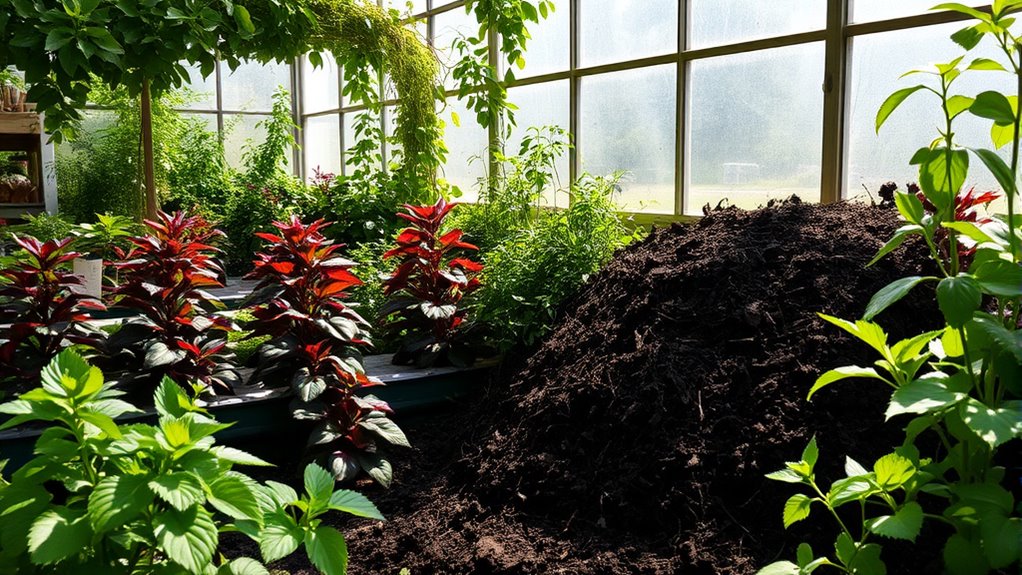
While you’re composting in your greenhouse, implementing complementary practices can significantly boost efficiency and nutrient quality.
Start by maintaining aerobic conditions; regularly turn your compost pile and ensure proper ventilation. Balancing carbon-rich “browns” and nitrogen-rich “greens” is crucial, aiming for a 4:1 or 3:1 ratio.
Maintaining aerobic conditions and balancing browns and greens is essential for effective composting. Aim for a 4:1 or 3:1 ratio.
Keep moisture levels consistent—your compost should feel like a wrung-out sponge to prevent odors and slow decomposition. Monitor temperatures, ideally reaching up to 155°F, to kill pathogens.
Additionally, strategically place compost bins to maximize space and heat distribution. Incorporating diverse organic materials and livestock manure enhances nutrient content, speeding up decomposition and improving overall compost quality.
These practices will help you create rich compost that benefits your greenhouse plants.
Best Practices for Successful Greenhouse Composting

To achieve successful greenhouse composting, it’s essential to follow best practices that maximize efficiency and nutrient quality.
Start by choosing an appropriate method, like aerobic composting, which promotes faster decomposition through regular turning.
Balance your materials by combining brown (like dry leaves) and green (such as kitchen scraps) to maintain an ideal carbon-to-nitrogen ratio.
Monitor temperature and moisture levels, keeping the pile as damp as a wrung-out sponge.
Select bins that allow air circulation and resist pests.
Position your compost away from residential areas to minimize odors and ensure good drainage.
Lastly, regularly turn your compost to aerate and distribute nutrients evenly, promoting a thriving compost system for your greenhouse.
Frequently Asked Questions
What Materials Are Best for Composting in a Greenhouse?
For composting in your greenhouse, focus on a balanced mix of carbon-rich materials like dry leaves and straw, paired with nitrogen-rich items such as fresh grass clippings and vegetable scraps.
You’ll want to include structural additives like twigs for aeration and crushed eggshells for calcium.
Avoid meat and dairy to deter pests, and ensure all materials are untreated.
Keeping moisture levels consistent is key for a successful composting process.
How Long Does Composting Take Inside a Greenhouse?
Composting inside a greenhouse typically takes three to six months, depending on your methods and conditions.
If you use aerated static piles and maintain proper aeration, you could see results in as little as three weeks. Higher temperatures can accelerate the process, while smaller material pieces break down faster.
Regularly turning and monitoring your compost will help achieve efficient decomposition, ensuring you get nutrient-rich soil for your plants sooner.
Can I Compost Meat and Dairy in My Greenhouse?
You can compost meat and dairy in your greenhouse, but it comes with challenges.
These items can attract pests, create strong odors, and pose pathogen risks if not managed properly.
If you decide to go ahead, ensure you maintain high temperatures and mix them with carbon-rich materials to help control odors and pests.
Just remember to monitor moisture levels carefully to keep your composting process efficient and safe.
How Do I Know When My Compost Is Ready?
How can you tell if your compost is ready?
Look for a dark, crumbly texture and a uniform appearance with no recognizable waste. It should smell earthy, feel moist like a wrung-out sponge, and have reduced in volume by about half.
Check the temperature; it should be at ambient levels, with no heat production.
Lastly, seeds should germinate well in it, confirming it’s ready for your garden.
What Tools Do I Need for Greenhouse Composting?
For greenhouse composting, you’ll need a few essential tools.
Start with a compost bin to keep everything organized.
Grab a shovel or pitchfork for turning the pile, and a rake to spread materials.
An aerator or compost tumbler will help with oxygen flow.
To check moisture and temperature, a moisture meter and thermometer are key.
Lastly, a compost sifter ensures you’re left with fine, ready compost for your plants.
Conclusion
In the grand tapestry of sustainable gardening, composting inside your greenhouse can be a game changer. By embracing this practice, you’re not just nurturing your plants; you’re also joining a movement towards a greener planet. While challenges exist, the benefits often outweigh them, making your greenhouse a thriving ecosystem. So, don’t hesitate to dig in and transform your waste into a fertile treasure—just like nature intended. After all, even the mightiest oak starts as a humble acorn.
